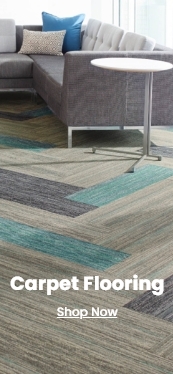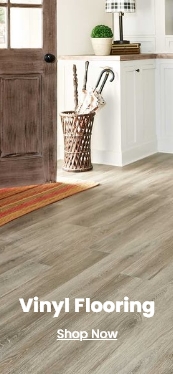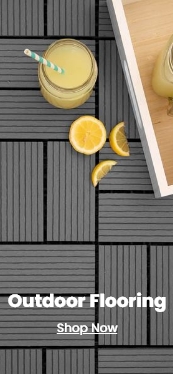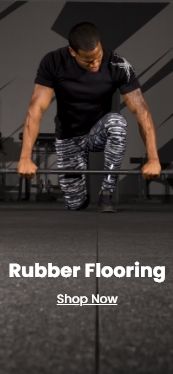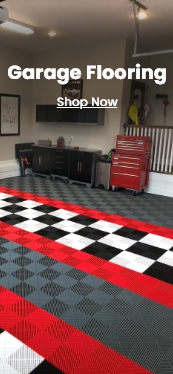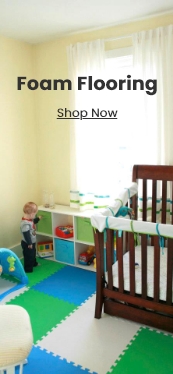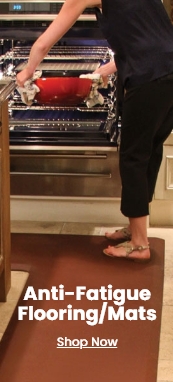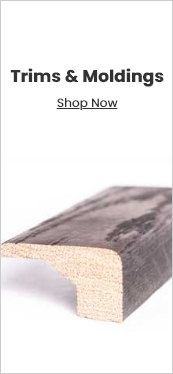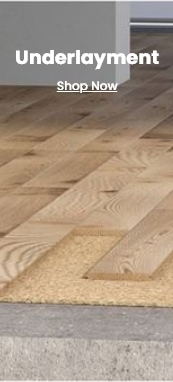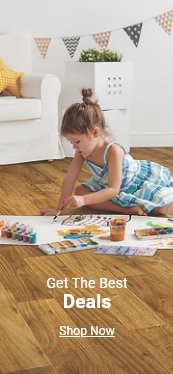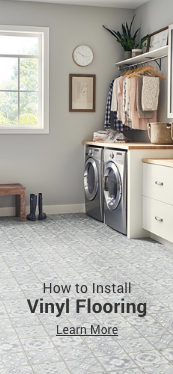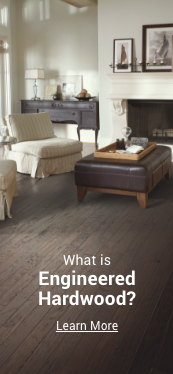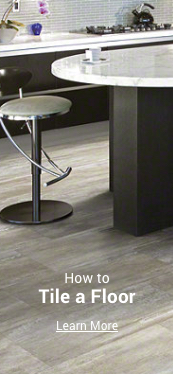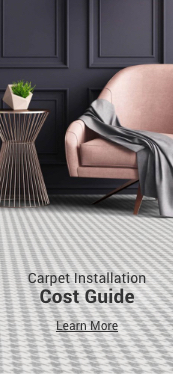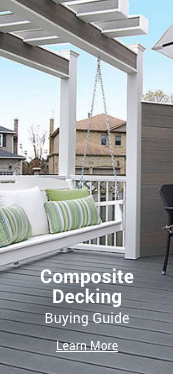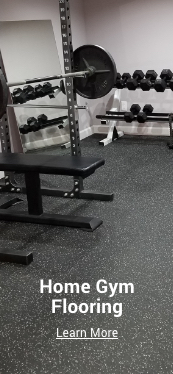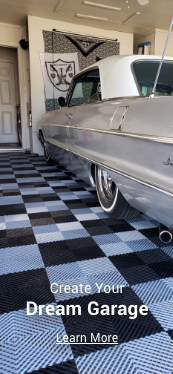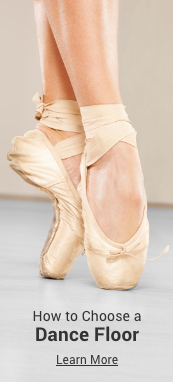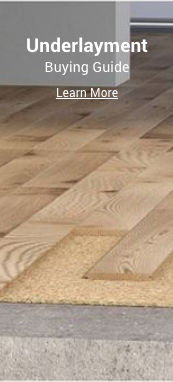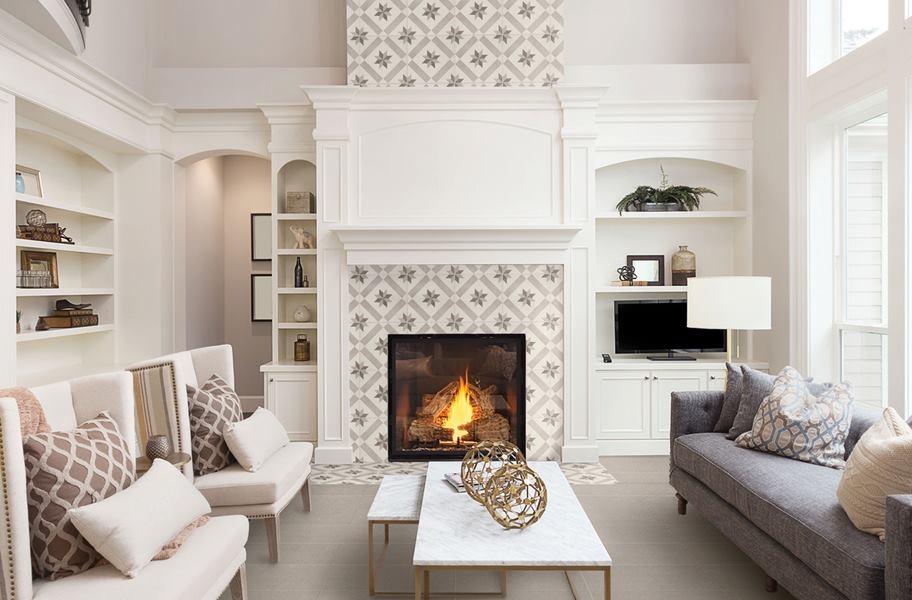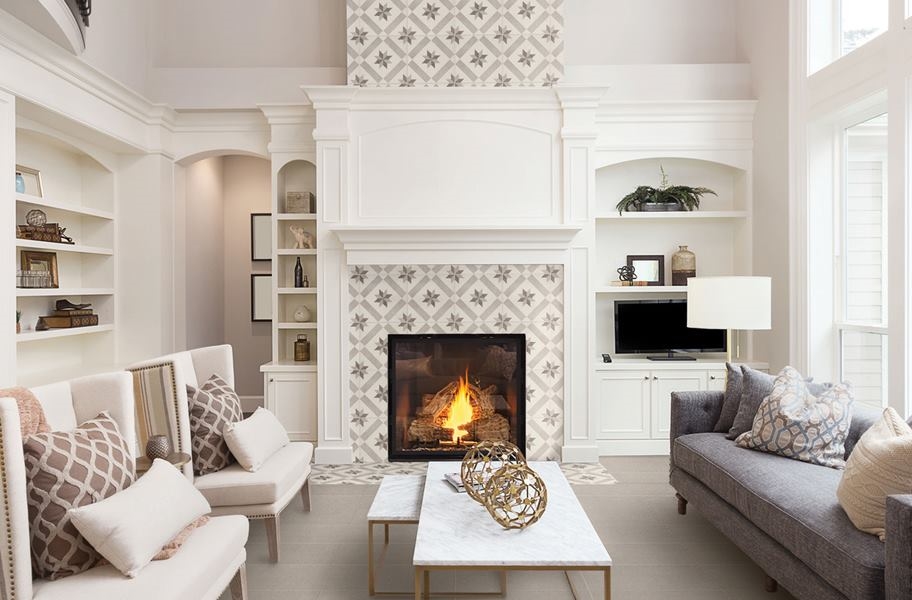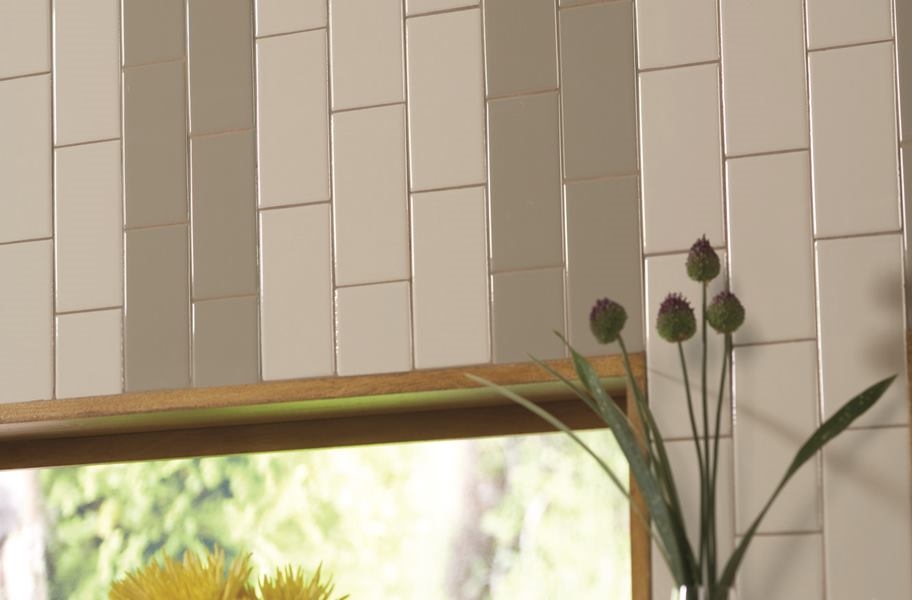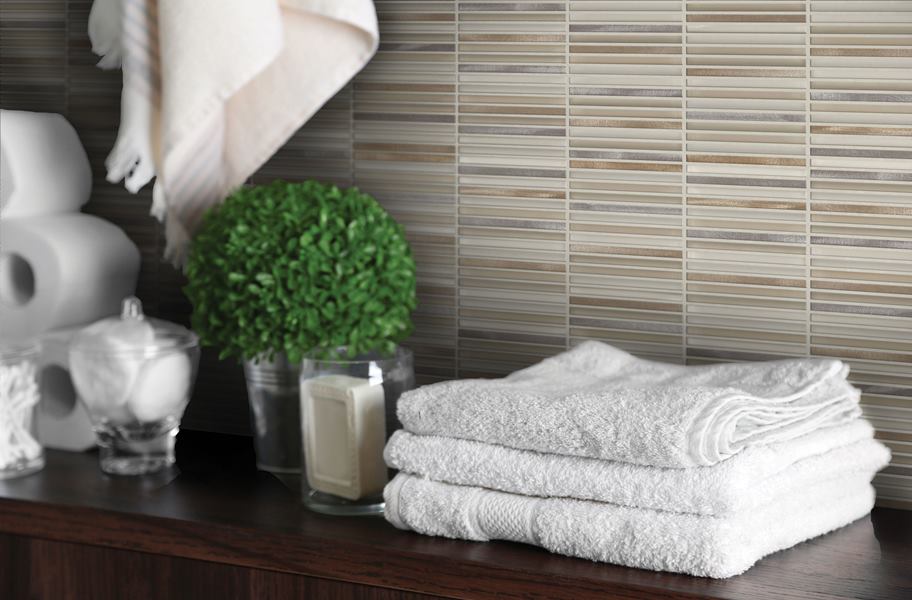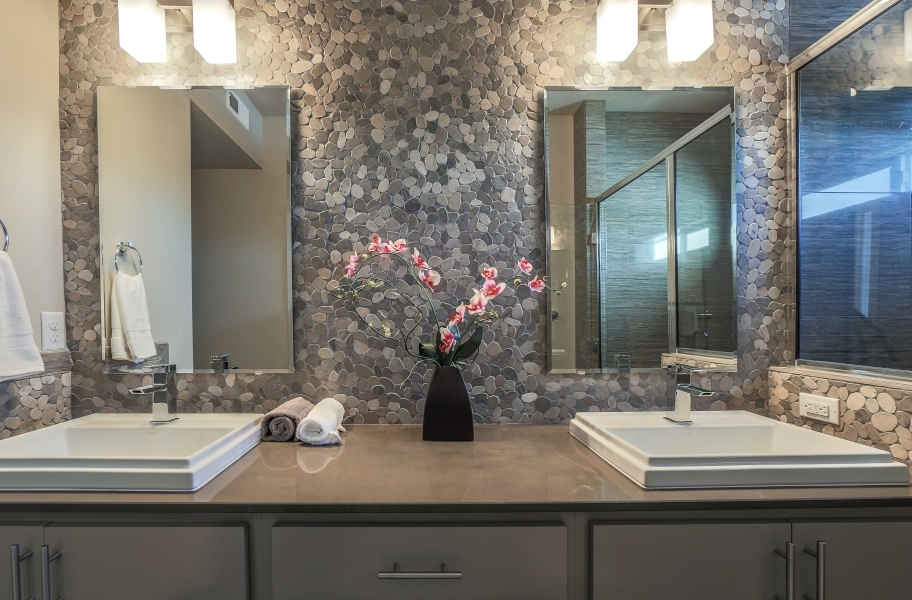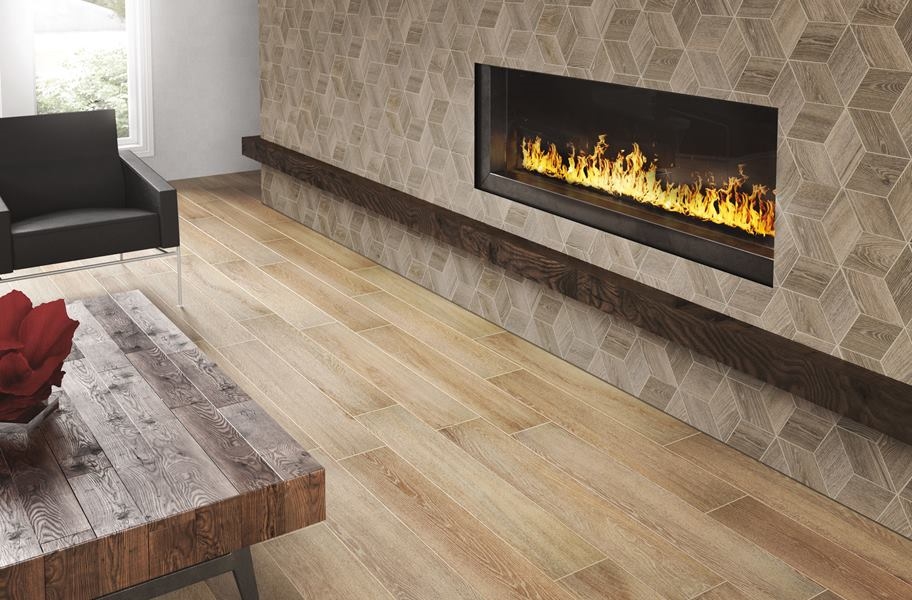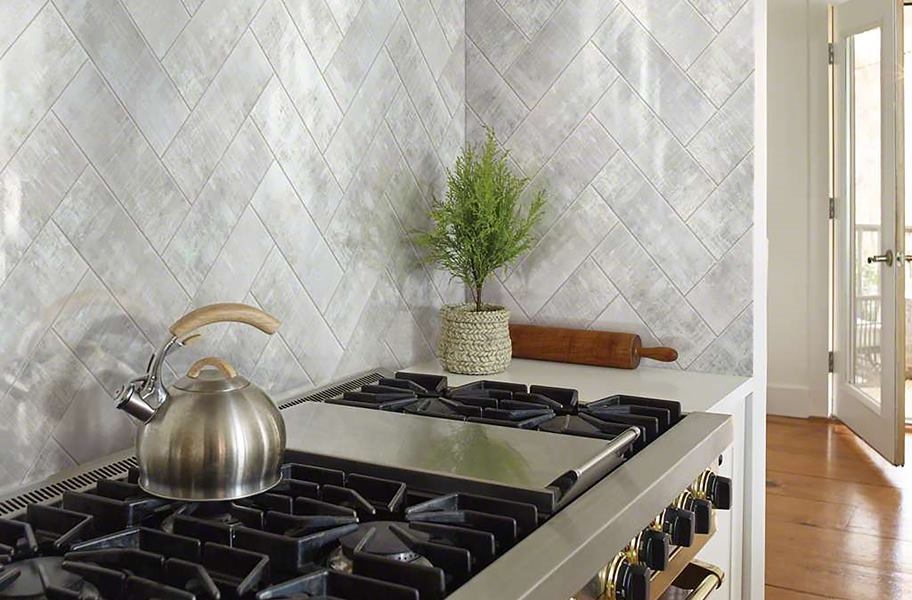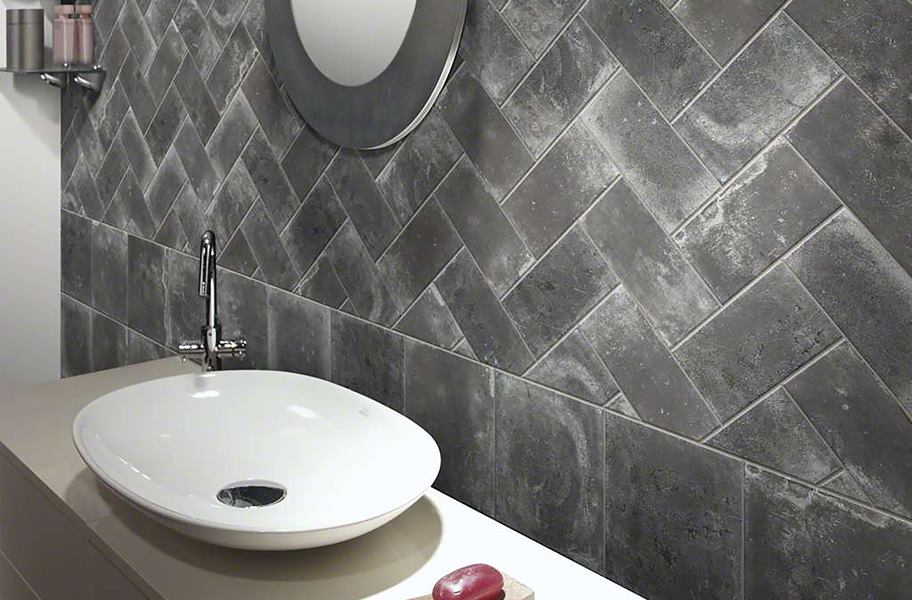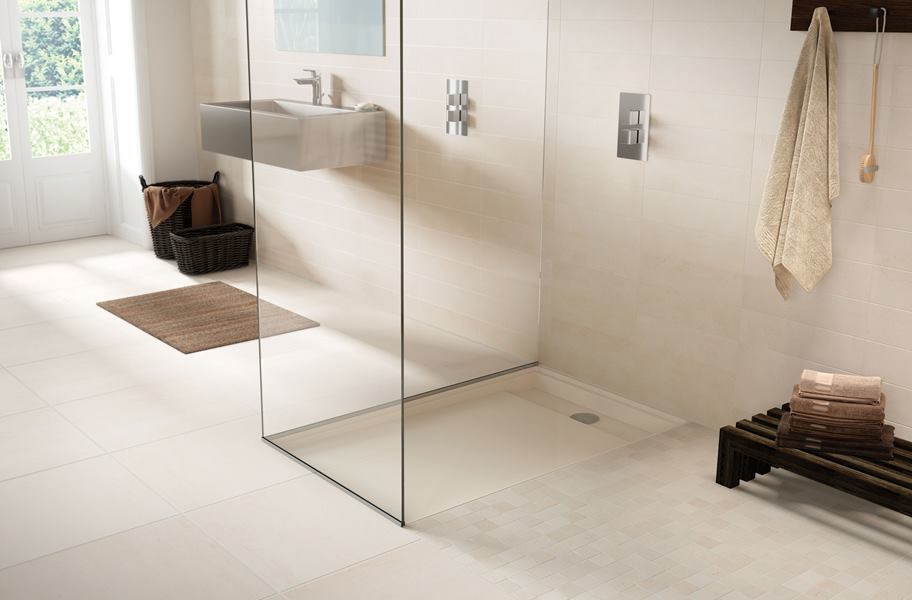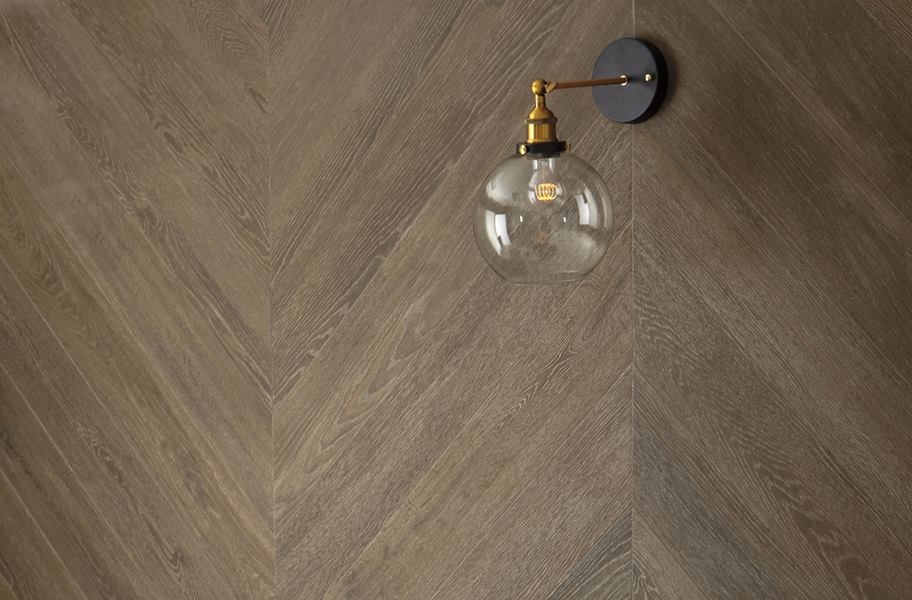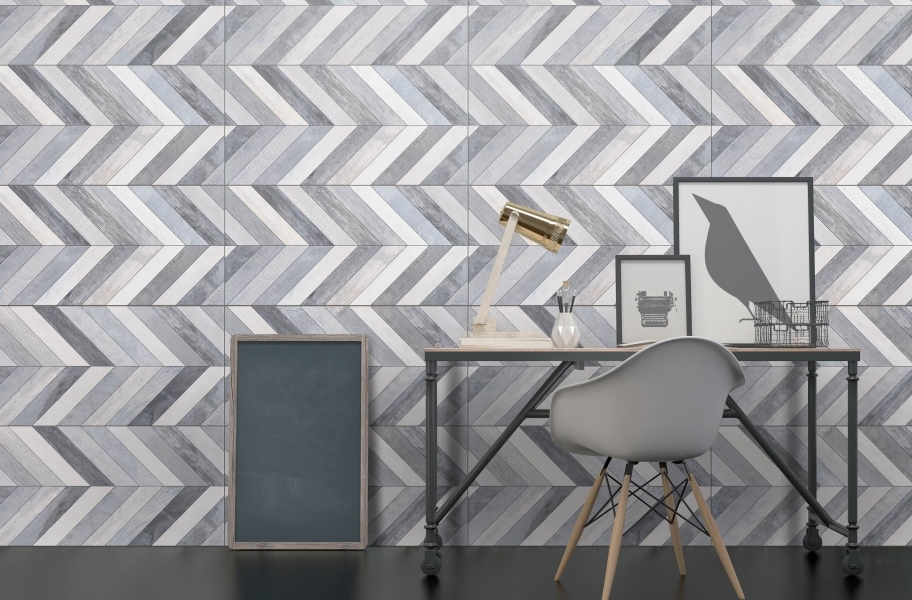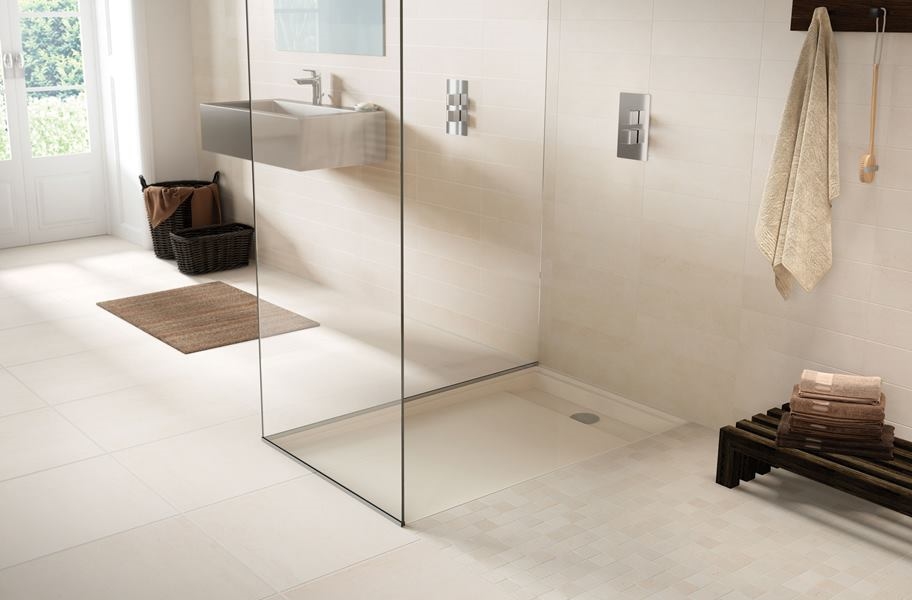Wall Tile Buying Guide: 15 Things You Should Know
| Fact Checked By: Ashley De Zeeuw
Published: January 31, 2020 | Updated: October 30, 2020
Wall tile offers a water-resistant surface that is both durable and stylish. Perfect for bathrooms, kitchens, backsplashes, and shower walls, porcelain and ceramic wall tiles are an affordable alternative to natural stone or bare walls.
While tile flooring has been around for decades, wall tiles haven’t always been as popular. In recent years, design innovations have created an explosion of styles, shapes, and colors in tile. This has really opened up the market to homeowners looking to update their space with a tile wall treatment.
It’s a brave new world out there, with lots to explore. As you consider wall tiles for yourself, use this guide to lead the way to your new favorite tiles.
Discover the different types of wall tile, the pros and cons, how to install it, and much more in this in-depth wall tile buying guide.
| Related Content >> Tile FAQ |
What Other Experts Are Saying
“Tile has long been a standard finish for kitchen backsplashes and wet areas of bathrooms because of its durability and ease of maintenance. In recent years, the explosion of style options has made it more of a design element. Subway tiles in larger formats, unique shapes and three-dimensional effects are trending. Glass, stone and metal continue to grow and are being intermingled in new and creative ways. Wall tile has become a relatively inexpensive way to add interest to a space.” – Steve Radford, Daltile
How is Wall Tile Different From Floor Tile?
Wall tile is made to be thin and light, so it adds less weight to the wall and is easy to install. It can also feature more detailed textures and decorative patterns. Meanwhile, floor tiles are thicker and sturdier, because they need to hold up to foot traffic. Floor tiles often don’t have a lot of detailed texture.
Since wall tiles can be thin, they’re not a good option for flooring. However, some floor tiles can be used for walls, depending on the size, weight, and the manufacturer’s instructions. It’s a good idea to consult a professional before choosing to install floor tile on your walls. Lots of factors go into determining how flooring tile will work as a wall treatment.
| Related Content >> Wall Tile Trends |
Types of Wall Tile
It’s easy to think that all tiles are the same, but there are key differences between ceramic, porcelain, and real stone tile. It’s likely that one kind of tile will be a better fit for you than the rest.
Ceramic Tile
Ceramic tile is composed of a clay and water mixture. This mixture is shaped into tiles before it’s dried and fired at high temperatures inside a kiln. Many ceramic tiles are then glazed, which makes them waterproof.
Unglazed ceramic tiles offer a more natural look that some people prefer, but they are only water-resistant, not waterproof.
Porcelain Tile
Porcelain tile is a more durable and dense version of ceramic. Because it’s kind of like an upgrade, people consider porcelain to be distinct from ceramic.
Porcelain is also made from a mixture of clay and water. The clay is often comprised of feldspar, kaolin, and quartz, which makes it more dense than ceramic clays.
Natural Stone Tile
Natural stone and marble tiles create the luxury looks that are so sought-after in bathrooms and kitchens. Those gorgeous color variations and patterns are in high demand, and there’s a stone for every style. Some of the most popular natural stone tiles include travertine, granite, limestone and more.
This kind of tile is a good option to consider if you have the money. Be aware, though, that natural stone requires more upkeep compared to ceramic or porcelain tiles. Natural stone needs to be regularly sealed and resurfaced to maintain its beauty and practical functionality.
| Related Content >> Porcelain vs. Ceramic Tile |
Tile Construction
Tile refers to all the types discussed above, but this section will go into detail on the process of creating ceramic/porcelain tile. Understanding how tile is made can help you determine if it’s a good fit for your application.
Layers of Ceramic Tile
Most ceramic tiles are comprised of two layers: bisque and glaze. The bisque is the body of the tile, and it’s the thickest layer. The glaze is the top of the tile, where the color sits. Some tiles don’t have a glaze – these tiles have through-tile construction, meaning since the color is solid all the way through.
Once the tile is formed and dried, a high-tech inkjet printer will add the desired colors and patterns. It’ll also be glazed to protect this image from wear and tear.
Firing Ceramic Tile
Once both ceramic and porcelain tiles are glazed, they will be fired to burn away any remaining moisture and to set the glaze. Porcelain is fired at an extremely high 2500F – higher than ceramic at 2000F. Since porcelain is fired at a higher temperature, and has denser clay materials, it becomes impermeable to water.
What is Tile Body Color?
The body color refers to the color of the bisque (or construction) that makes up the base of the tile. Body color doesn’t always match the top glaze, so if the glaze is chipped, the body color can be revealed.
Ceramic tiles typically have a red body, and they won’t match the glaze in most cases. For some porcelain, it’s a different story. Some porcelain is manufactured with a through color, if the surface chips, the body color and pattern underneath will be the same. This is called “through body porcelain.”
There is also something called color body porcelain, for porcelain tiles that have a multi-color glaze on top. In color body porcelain, the bisque of the tile matches the dominant color in the glaze. This design can often hide the appearance of chips, though not as completely as through body tiles.
| Related Content >> Floor Tile Buying Guide |
Pros of Wall Tiles
- Customization: No wall covering is as versatile as tile. You get to determine every aspect, including the size, shape, color, pattern, and finish. If you’ve got a particular design in mind, you can easily achieve it.
- Durable: This is porcelain and ceramic we’re talking about here. It can hold up to the bumps and scrapes that walls can sometimes face. Porcelain is especially durable and scratch-resistant.
- Stylish: Since tile is shaped and printed with a glaze, it can look like basically anything. That means there are constantly new designs coming out to reflect the latest trends.
- Waterproof/resistant: Glazed porcelain tiles are completely waterproof, and so are glazed ceramic tiles. Tile is one of the most reliable materials to use for showers and backsplashes.
Cons of Wall Tiles
- Difficult installation: It’s no secret that tile can be tough to install, and that’s not just for floor tile. Installing wall tile presents its own unique challenges, since you have to make sure your tiles don’t slip down the wall before the mortar is completely dry. It’s not completely impossible to install on your own, but a professional is highly recommended.
- Cost: Tile is stylish, durable, and in most cases, waterproof. All those benefits are going to come with a heftier price tag than if you were to simply paint your wall. But who wants boring paint when you can spice up your space with tile?
| Related Content >> Accent Wall Ideas |
Wall Tile Sizes
Rectangular/Subway Tiles
Rectangular tiles come in a range of size options, from subway tiles to much larger planks. Subway tiles themselves aren’t a single size, either.
Typically, you can find Subway tile in sizes from 1” x 3” to 4” x 16” which gives you the option to select the best size for your use. Smaller subway tiles might look best in a backsplash, but maybe you would want something larger for the shower wall, so you have less grout to clean.
Plank Tiles
Plank-shaped tiles are typically for wood looks, but they don’t have to be. You might think a plank wouldn’t have a lot of size variation, but that’s not the case! Planks come in a range of sizes, especially since the wide plank trend has gained popularity. You can find sizes from 6” x 24” to 12” x 48” in tile planks.
Large Format Tiles
If a tile has one edge that’s 15″ or larger, it’s considered a large format tile. These large tiles are becoming more and more popular, and there are a lot of reasons for that.
A larger tile covers more surface area, so there’s less grout to clean. Plus the oversized dimensions can make a space feel larger. For wall tiles, you’ll see lots of large format rectangles that are oriented vertically to create the sense of a much taller room.
Square Tiles
Any square tiles ranging in size from 2” – 24” are considered standard sized tiles. Square wall tiles are most commonly 6” and larger.
These tiles are easier to install and easier to measure than larger sizes. Many of the most classic tiled walls are made from standard size square tiles.
Mosaic Tiles
Mosaics are made of tiny tiles ranging from .5” – 2” in one dimension. Mosaic tiles can be squares, circles, and sometimes even thin “strips” of tile. They’re popular in backsplashes, showers, and anywhere that could use a tile accent.
While beautifully detailed, mosaics can make for a busy wall, so it’s a good idea to keep mostly clean lines in the rest of the space.
| Related Content >> Tile Flooring Trends |
Wall Tile Styles
- Glass: There’s something about the shimmer of glass that’s so eye-catching! Glass tiles are now available in pre-assembled mosaic tile sheets. These sheets can be easily cut to fit and installed as a backsplash or shower accent. Some of these innovative mosaic sheets are combining a variety of materials – including glass, stone, and ceramic – in a single unique design.
- Wood-look: Wood visuals are super popular for flooring these days, but wood-look tiles are also great for creating an accent wall. Wood wall tiles can go with any style, from shabby chic farmhouse to cool and contemporary. Best of all, manufacturers are now creating mosaic wood panels or sheets, so part of the project is already completed for you!
- Stone-look: Marble-look and stone-look tile is a classic look that will always be in style. It creates an elegant, luxurious atmosphere, especially in showers and backsplashes. Stone-look wall tiles are sure to add resale value to any home.
- Decorative/Patterned: Patterned wall tiles are the hottest new trend. You can find decorative wall tiles in a wide range of styles, from retro and vintage to farmhouse and Moroccan. Many decorative tiles are made to look like the popular encaustic cement tiles, and they add a touch of color and personality to any space.
| Related Content >> Backsplash Tile Trends |
| Related Content >> How to Choose Tile |
Shapes
Unique tile shapes are becoming the norm. Discover what options are out there beyond simple squares and rectangles.
- Hexagons: At once modern and classic, hexagon tiles are perfect in a mosaic design, or in more creative, abstract patterns. Keep an eye out for unique tile transitions using hexagons.
- Fans/Fish scales: Fan tiles are one of the biggest trends in bathroom wall tiles right now. This unique shape evokes the idea of fish scales (in a pretty, elegant way – not in a gross, fishy way).
- Arabesques: When you’re going for an elegant and ornamental style, nothing can beat arabesques. These creative, curvy tiles are especially popular with a marble-look style.
- Stars and crosses: This intricate style actually involves two tile shapes! The stars and crosses interlock together for a bold but classy pattern.
- Penny rounds: For a fun and modern look, circular tiles are a great option. Also known as penny tile, this rounded tile is often smaller and installed in a mosaic style.
- Diamonds: For a modern twist on a classic, introduce diamond-shaped tile to your space. The diagonal lines engage the eye and make any room seem larger.
- Subway tiles: You can’t forget about subway tile! While not as adventurous as other shapes, it’s still wildly popular. In fact, it’s hard to find a kitchen or bathroom these days that doesn’t include subway tile in some way.
Tile Patterns
-
- Grid/stacked: This simple and modern pattern looks exactly like how it sounds. Square or rectangular tiles are set in straight, clean lines to create a traditional look.
- Offset/staggered brick: This is the most common pattern for laying bricks. Typically, the end of one tile is centered over the tile below it, but you can choose other offset ratios. This pattern is also known as a running bond.
- Herringbone: Rectangular tiles are set against each other at 45 degree angles, creating detailed, intricate tile designs. This look is popular with subway tiles.
-
- Diagonal: Square tiles are laid at a 45 degree angle in a diamond pattern. The diagonal style is used to make smaller spaces seem larger.
- Basket weave: A combination of larger rectangular tiles and small square tiles mimics the pattern of a woven basket. This pattern works in classic and contemporary styles.
- Versaille: To get a classy Versaille pattern, use four sizes of square and rectangular tiles in a repeating, interlocking design. This style is also known as the French pattern.
| Related Content >> Backsplash and Mosaic Tile Guide |
| Related Content >> Tile Pattern Trends |
Textures of Wall Tile
- Stacked stone, brick, or slate: This natural look is meant to mimic the style of a stacked stone wall, with lots of size and color variations between the stones. It’s a very intricate design that tends to go in and out of style.
- 3-D man-made designs: More modern or contemporary spaces have been experimenting with dimensional tiles in abstract shapes and patterns that “pillow” out slightly. These surfaces are often glossy and smooth. On the other end of the style spectrum, you’ll find 3-D tiles with intricate Victorian patterns and matte finishes.
- Glazed tiles: A smooth, glazed tile is timeless and classic. They create a clean, contemporary look that won’t go out of style.
- Encaustic cement look: The patterns and detailing of encaustic cement tiles are really popular right now. Manufacturers are now creating porcelain and ceramic tiles made to look like encaustic cement with a more affordable price tag.
Wall Tile Finishes
“Home finishes follow fashion trends. We are seeing now, more than ever, the affect that fashion can have on home finishings market. There are many tile options that have texture, pattern and color that exude the classics of men’s suiting and fabrics. In addition, 2020 has brought more metallic options with raised lace patterns and texture in metallic colors for really bold spaces.” Cynthia Flottmann, Roux Design Studio
- Matte or Honed: The big trend these days is to move away from the gloss and toward subtle, more natural-looking surfaces. Matte finishes are less slippery, and the honed appearance does a better job of disguising scuffs and scratches than the typical high-gloss tile.
- Shiny or Glossy: I know, I know. I just finished saying that gloss is on the way out, but the truth is, shiny finishes on tile aren’t ever going to go away completely. That’s the classic look, and it will stick around for the foreseeable future.
- Metallic: Metallic-look tiles are a recent trend in modern and contemporary spaces. While they’re not necessarily a good style fit for everyone, they do add a unique personality to your wall when used as an accent.
- Mirrored: Like metallic-look tiles, mirrored finished are more of a niche market, and a little bit goes a long way. Still, it’s great to have the option. I mean…mirrored tiles! How cool is that?
Where to Use Wall Tiles
- Shower: This is one of the most classic uses of wall tile. Since glazed porcelain and ceramic tiles are waterproof, they’re a popular option for any area that’s going to see a lot of moisture.
- Bathroom: Why just stick to tiling the shower when you could upgrade the whole bathroom? Since so many waterproof options are also stylish, you can add some patterns or colors to avoid a bland, white bathroom
- Backsplash: Tile is the most popular solution for protecting walls from the hazards of cooking and cleaning. Most backsplashes come as tile sheets to simplify installation.
- Kitchen: The entire kitchen can benefit from wall tiles, not just the backsplash! You can enjoy the style and durability of tile in one of the busiest rooms of the home.
- Accent wall: Tile is versatile enough to work in any room of the home. Whether you want to spice up your entryway or add a touch of personality in the living room, you can get it done with a tastefully tiled accent wall.
| Related Content >> How to Install Backsplash Tile |
How to Tile a Wall
Hanging wall tile is a similar process to tiling a floor, but the vertical surface adds some complications. Tiles have the potential to slide down. Plus obstructions like walls, windows, and doors can require lots of extra cutting.
Some people might consider this too much of a challenge to tackle it as a DIY project, but for those dedicated weekend warriors, it’s not impossible. With the right preparation and tools, you can install wall tile on your own.
Before you start tiling, make sure your walls and floor are squared up, or plumb, by using a level. The last thing you want is to evenly install tile on an uneven wall, and have all your hard work go to waste. If the walls are really “un-square” then you can use trim and baseboards to square up the look of the room before you start.
But what if you’re tiling the walls and the floor at the same time? Where do you start? Don’t worry. When tiling a floor and a wall together, you should start with the wall first, but leave the bottom row of tile empty until the floors are completed. This method saves you the most time, and decreases the risk of you messing up your brand new floor while working on the walls.
Tips to Prevent Slippage When Hanging Wall Tile:
- Build up in a pyramid shape: This method allows for more support for your tiles. Creating a solid base of tiles near the bottom of the wall will prevent slipping and sliding as you work higher up.
- Hang a batten board: A batten is a squared board that holds up the tile as you install, preventing slips. It can also be used as a placeholder for tiles that you will fill in later (such as accent tiles).
- Use a mastic adhesive: Mastic is a kind of tile adhesive that’s extra thick and sticky. Tile sticks to it faster than other adhesives. However, mastic isn’t as water-resistant as thinset mortar, and the bond isn’t necessarily as strong, either.
| Related Content >> How to Tile a Floor |
How to Clean and Maintain Wall Tiles
Tile itself is pretty simple to clean, but you need to make sure you have the right tools for your material. Cleaning porcelain or ceramic tiles is different from cleaning a porous surface like a natural stone or marble tile.
| Related Content >> How to Clean Tile Floors |
How to Clean Ceramic and Porcelain Tile
Glazed ceramic and porcelain features a smooth, non-porous surface that isn’t going to absorb any moisture or staining. That makes man-made tile really easy to clean and maintain.
Simply wipe down any dirty tiles with a household tile cleaner of your choice, and watch as they look just like new. There’s no mold, and no mildew. Just beautiful tile walls.
How to Clean Natural Stone Tile
Porous surfaces like real stone, marble, travertine, and limestone can be penetrated by caustic cleaners, which will stain the tile. Caustic cleaners include products like bleach and vinegar.
To gently clean natural stone without damaging the surface, it’s a good idea to use a dedicated store-bought stone cleaner. This takes all the guess-work out of cleaning.
However, if you’re really invested in using a homemade cleaner, stick to gentle methods, like soapy water, or water and baking soda.
Regardless of what you use, you should always test a cleaning solution in a place that isn’t obvious, to confirm there won’t be any surface damage. Plus, as always, it’s crucial to follow the manufacturer’s instructions for maintenance.
How to Clean Grout
While tile is relatively simple to clean, grout is another matter. Unless you have epoxy grout, or a sealer was mixed in during installation, all your grout will have a porous surface that should be sealed regularly (about once a year). As you can guess, not a lot of people are actually doing this.
So what happens when grout isn’t sealed? That porous surface can absorb stains and moisture, which can then lead to mold and mildew build-up. No thanks!
There are plenty of methods to clean grout, ranging from homemade solutions to tougher, store-bought products. Most of the time, you can get the job done with a soft bristled brush, some soapy water, and a bit of elbow grease. For those tougher grout lines, there are other cleaning solutions you can try, including baking soda or hydrogen peroxide.
| Related Content >> How to Clean and Seal Grout |
Why You Should Choose Wall Tiles
Just in case you’re not fully convinced, here are just a few of the reasons wall tile could be great for you.
-
- Customization: No wall treatment option offers you as many choices as tile. You get to pick the exact material, color, size, shape, finish, and pattern that best fits your personal look.
- Versatile: Wall tile isn’t fussy like wallpaper or paint. It works in every room without issue, including kitchens and bathrooms.
- Durable: Tile is tough, and that makes it great for preventing stains and scratches. Install subway tile or large format tile in your busiest room and marvel at how well it holds up.
- Stylish: You can easily purchase tile in the latest shapes and styles if you want a trendy look.
- Large selection: The options are virtually endless. You get to choose the size, color, shape, texture, and even the finish. That means you’re going to get exactly the kind of tile you want.
- Waterproof or water-resistant: All glazed porcelain and ceramic tiles, are completely waterproof. That’s why tile is so common in kitchens and bathrooms. You don’t have to worry about standing water causing damage in your home.

